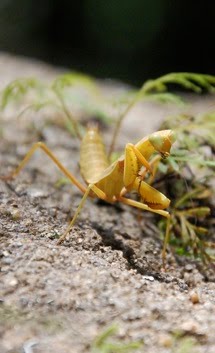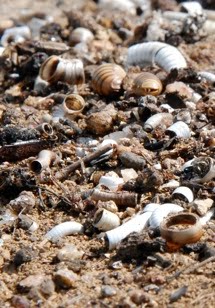The Lesser of Two Weevils
You do not look the same as a boy. Unless of course you are a boy. In that case, you do not look like a girl.
That is not always true. Yesterday we learned that those common, but still cute, brown lemurs look alike. Boy and girl brown lemurs are about the same size, weight and color.

But that is a funny thing in the animal world, because most boys and girls look different. In science-speak, that's called dimorphism (try using that in the dinner table conversation tonight).
For humans, males are usually taller. Woman usually have narrower shoulders. And think of birds. Most male birds go around bragging and boasting their colorful plumage while the females get stuck with the dull end of the feather. Those stunning red cardinals flitting around the feeders right now are all boys. The gray brownish birds looking jealous nearby are the females.

But it's not just us and the birds. Even insects get into the act. Insects have boys and girls too and most of them are different from each other. Sometimes it can be hard to tell, but not with these two lovely weevils.

There are weevils weeviling around the United States and Europe and Asia and all over the world, but none like these two. These are giraffe weevils, Trachelophorus giraffe, and they can only be found in Madagascar. In science-speak, that would make them endemic to Madagascar.
The first two pics show a male giraffe weevil and his long neck that bends like a crane. His neck can be 2-3 times longer than the neck of a female like the one in the last two pics. That long neck isn't used for fighting or for changing hard to reach lightbulbs though.
The lanky head-holder helps him build a nest by rolling up a leaf and fixing it into a tube. If the shorter necked female likes his handy work, she lays a single egg in the nest and in a few weeks a baby giraffe weevil pops out--presumably head first.
The hungry little weevil larva doesn't have to look to hard to find food. That leaf fort that Dad built is not only warm and safe; it's also tasty. In fact, it's usually a leaf from the giraffe weevil's favorite tree...the giraffe weevil tree.
Coincidence?







10 comments:
LB- Mrs. Lewis' Class
"I remember that lemurs can jump to other trees."
"Lemurs make loud noises."
"What do lemurs do during the day?"
"Lemurs can dance."
"Lemurs have fights with their stinky tails."
"Lemurs have yellow eyes."
"Scientists collect lemur poop."
This class sure remembers a LOT about lemurs. We enjoyed looking at the giraffe weevils and learning about boy and girl insects.
Dear Mrs. Lewis' Class,
Thank you for the wonderful comments, you smarties. You remembered so much.
And to answer your question about what lemurs do all day: The nocturnal lemurs sleep during the day, so that they are nice and rested to spend the night in search of delicious food. And the diurnal lemurs, the ones who are out in the daytime, spend the day scouring the trees and sometimes the ground for tasty treats to fuel their bodies. They also take time to clean themselves and rest.
Good question. Come back soon.
Eli Lebo
What is your favorite animal in Madagascar? Do you know what is the most endangered and most common animal in Madagascar? As soon as I saw the Giraffe Beatle I said “hey that’s a Giraffe Beatle!
Dear Eli,
Great job animaniac! I don't think I would have know what it was at your age.
My favorite animals in Madagascar so far are the insects. I especially like the dragonflies and praying mantids.
There are many animals here that are endangered. Most of them actually are threatened or endangered. It would be hard to say what the most endangered ones are. Some of the frogs and smaller animals are sometimes only found in one single hill or valley, so one fire or flood or farmer can wipe them out and make them extinct.
The most common animal is probably the mosquito. There are also a lot of these whimsical little black and yellow birds called wagtails. They seem to be everywhere.
Mrs. Schwimmer's class-
Have you seen many giraffe weevils? Are they rare? How big are they? We're thinking that if they lay one egg at a time, they must be kind of hard to find.
Lizzy- are they dangerous?
Zoe- Do they live in groups?
Annie- how often do they lay eggs?
Maria- Do the babies stay with the adults?
Isaiah- Do the females use their necks for any purpose?
Alex- What other weevils have you seen?
Sawyer- Do other weevils eat the nests?
Maybelle- Were the weevils in the pictures adults?
Christina- Are weevils different colors?
Jasper- Do males use their necks for anything else?
Brian- Do the females have any special adaptations?
Daniel- How many different types of weevils are endemic to madagascar?
Nicholas- How do the long necks help the males roll the leaf nests?
Abby- Do weevils make sounds?
Mrs. Dougherty- Have you seen any really large praying mantises?
Andrew- Did you know about giraffe weevils before you went to madagascar?
Gabriel- Are there different types of praying mantises in madagascar?
Mrs. Gargione's class-
Maddie- Why do the weevils have red backs?
Gianluca-How big do the weevils get?
Michael- Do the weevils eat other trees?
Kai-How fast can weevils move?
Annabelle- Do weevils fly?
Annafleur- Does the male have a long neck even when it's a baby?
Sylene-How do the females lay their eggs?
Mrs. Livingston's Class-
Fia- Are there any bugs that give you the creeps?
Audrey- I've never seen a weevil in Nj. What do they look like? Where would I find one?
Alexandra- Are giraffe weevil trees also endemic to Madagascar?
Dear Mrs. Schwimmer's Class:
I have not seen exactly three giraffe weevils: the two in the photo and a juvenile one on a pumpkin flower at the children's home. They aren't that rare, but they only live on certain parts of the island, so it is hard to see them.
As for all you wonderful questions, I will try and answer some but you may to do some research of your own to get all the answers.
Giraffe weevils are not dangerous. They are picky eaters, so they do live in groups on their favorite tree...the giraffe weevil tree. Babies do not stay with their parents, because, like most insects, the parents are usually dead when the babies hatch. I don't know if other weevils eat the nest, but that is a smart and cool question. The long next helps them roll up the leaf by letting them reach into the tube as it forms with out trapping their wider bodies. I did know about them before I came and I have been wanted to see one ever since I landed over a year ago. I have seen a lot of praying mantises here, but none as big as the ones in New Jersey yet.
Dear Mrs. Gargione's Class,
I'm no weevil expert, so I will answer some but not all of your weevil inquires.
Weevils have red backs, because in the wild natural world red usually means, "Stand back, bucko! And don't even think about eating me." Some red plants and animals are poisonous and some are just faking it. This kind of weevil only gets about 15 mm long or so. Weevils do indeed fly. They are beetles and all beetles can fly. They do have a long neck even as babies. They can move pretty fast when they fly, but they aren't too snappy when they crawl. They can eat other trees, but the giraffe weevil prefers the giraffe weevil tree.
Dear Mrs. Livingston's Class,
So far, no. I don't know of any bugs that give me the creeps, but some of the big spiders make be a wee bit nervous. There are weevils all over the world and that includes New Jersey. Weevils look like little beetles holding straws in their mouths. They have long pointy mouth parts. Many like to eat grains, so you might even find one in your kitchen at home. The giraffe weevil tree is endemic to Madagascar too. Fantastic question.
Post a Comment